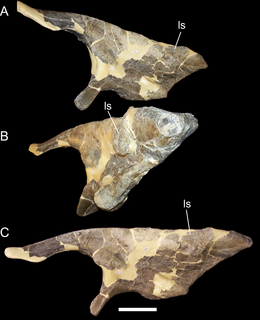| Gres a Avicula contorta Stratigraphic range: Late Norian [1] | |
|---|---|
| Type | Geological formation |
| Location | |
| Country | |
The Gres a Avicula contorta is a geological formation in France. It dates back to the late Norian. [1]
| Gres a Avicula contorta Stratigraphic range: Late Norian [1] | |
|---|---|
| Type | Geological formation |
| Location | |
| Country | |
The Gres a Avicula contorta is a geological formation in France. It dates back to the late Norian. [1]
| Dinosaurs of the Gres a Avicula contorta | ||||
|---|---|---|---|---|
| Taxa | Presence | Notes | Images | |
Indeterminate [2] | ||||
Indeterminate remains. [1] | ||||

The Lance (Creek) Formation is a division of Late Cretaceous rocks in the western United States. Named after Lance Creek, Wyoming, the microvertebrate fossils and dinosaurs represent important components of the latest Mesozoic vertebrate faunas. The Lance Formation is Late Maastrichtian in age, and shares much fauna with the Hell Creek Formation of Montana and North Dakota, the Frenchman Formation of southwest Saskatchewan, and the lower part of the Scollard Formation of Alberta.

The Judith River Formation is a fossil-bearing geologic formation in Montana, and is part of the Judith River Group. It dates to the Late Cretaceous, between 80 and 75 million years ago, corresponding to the "Judithian" land vertebrate age. It was laid down during the same time period as portions of the Two Medicine Formation of Montana and the Oldman Formation of Alberta. It is an historically important formation, explored by early American paleontologists such as Edward Drinker Cope, who named several dinosaurs from scrappy remains found here on his 1876 expedition. Modern work has found nearly complete skeletons of the hadrosaurid Brachylophosaurus.

Cedrorestes is a genus of iguanodontian dinosaur from the Early Cretaceous of Utah. It is based on an incomplete skeleton which was found in the Valanginian-age Yellow Cat Member of the Cedar Mountain Formation.
The Twin Mountains Formation, also known as the Twin Mountain Formation, is a sedimentary rock formation, within the Trinity Group, found in Texas of the United States of America. It is a terrestrial formation of Aptian age, and is notable for its dinosaur fossils. Dinosaurs from this formation include the large theropod Acrocanthosaurus, the sauropod Sauroposeidon, as well as the ornithopods Tenontosaurus and Convolosaurus. It is the lowermost unit of the lower Cretaceous, lying unconformably on Carboniferous strata. It is overlain by the Glen Rose Formation. It is the lateral equivalent of the lower part of the Antlers Formation.

The Bushveld Sandstone is a geological formation dating to roughly between 201 and 189 million years ago and covering the Carnian to Norian stages. The Bushveld Sandstone is found in Transvaal, South Africa and is a member of the Stormberg Group. As its name suggests, it consists mainly of sandstone. Fossils of the prosauropod dinosaur Massospondylus have been recovered from the Bushveld Sandstone.
The Löwenstein Formation is a lithostratigraphic formation of the Keuper in Germany. It is underlain by the Mainhardt Formation and overlain by the Trossingen Formation. It dates back to the middle Norian.

The Forest Marble is a geological formation in England. Part of the Great Oolite Group, it dates to back to the late Bathonian stage of the Middle Jurassic.
The Camadas de Guimarota, simply Guimarota, or Camadas de Alcobaça is a disused coal mine near the city of Leiria in central Portugal. The mine is within layers of the Alcobaça Formation, Kimmeridgian age of the Late Jurassic period, it contains a diverse array of fossil animals and plants, including dinosaurs and mammals.

The Shishugou Formation is a geological formation in Xinjiang, China.

The Paw Paw Formation is a geological formation in Texas whose strata date back to the late Albian stage of the Early Cretaceous. Dinosaur remains are among the fossils that have been recovered from the formation.
The El Picacho Formation is a geological formation in Texas whose strata date back to the Late Cretaceous. Dinosaur remains are among the fossils that have been recovered from the formation. The paleosols found here are rich in clay, calcite, and rhizoliths which show that during the Cretaceous period, this fossil formation, just like the neighboring Javelina Formation and Aguja Formation, was a fluvial flood plain.
La Bocana Roja Formation is a geological formation in Baja California, Mexico whose strata date back to the Late Cretaceous. Dinosaur remains are among the fossils that have been recovered from the formation.

The Trichinopoly Group is a geological formation in India whose strata date back to the Late Cretaceous. It lies between the Ootatoor and Ariyalur Groups. It is broad in its southern extremity but thins as it gradually proceeds northwards as it ultimately meets the Ariyalur Group. Dinosaur remains are among the fossils that have been recovered from the formation.
The Minhe Formation is a geological formation in northwestern China, whose strata date back to the Late Cretaceous period.
The Viñita Formation is a geological formation in Coquimbo, Chile, whose strata date back to the Late Cretaceous. Dinosaur remains are among the fossils that have been recovered from the formation.

The Quiriquina Formation is a geological formation in Chile whose strata date back to the Late Cretaceous. Dinosaur remains are among the fossils that have been recovered from the formation. The glauconitic sandstones and conglomerates of the formation were deposited in a marine environment.

The Allen Formation is a geological formation in Argentina whose strata date back to the Late Cretaceous (middle Campanian to early Maastrichtian. Dinosaur remains are among the fossils that have been recovered from the formation.
The Kagidani Formation is a Mesozoic geologic formation in Japan. Fossil ornithopod tracks have been reported from the formation.

The Chipping Norton Limestone is a geological formation in the Cotswolds, England. It preserves fossils dating back to the Bathonian. Including those of dinosaurs Cetiosaurus, Megalosaurus and Cruxicheiros as well as the Tritylodontid Stereognathus. It primarily consists of ooidal limestone.